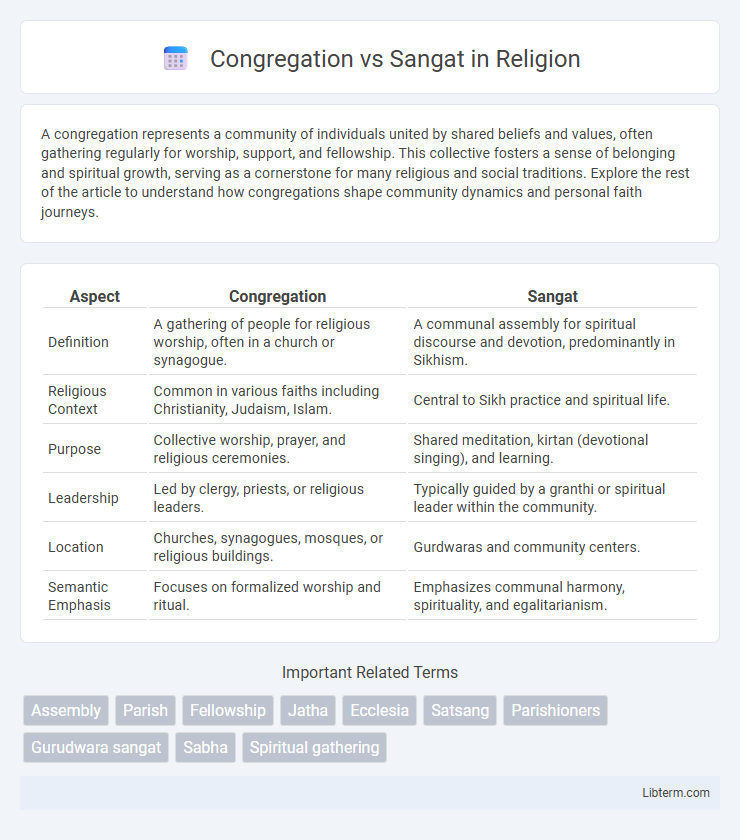A congregation represents a community of individuals united by shared beliefs and values, often gathering regularly for worship, support, and fellowship. This collective fosters a sense of belonging and spiritual growth, serving as a cornerstone for many religious and social traditions. Explore the rest of the article to understand how congregations shape community dynamics and personal faith journeys.
Table of Comparison
| Aspect | Congregation | Sangat |
|---|---|---|
| Definition | A gathering of people for religious worship, often in a church or synagogue. | A communal assembly for spiritual discourse and devotion, predominantly in Sikhism. |
| Religious Context | Common in various faiths including Christianity, Judaism, Islam. | Central to Sikh practice and spiritual life. |
| Purpose | Collective worship, prayer, and religious ceremonies. | Shared meditation, kirtan (devotional singing), and learning. |
| Leadership | Led by clergy, priests, or religious leaders. | Typically guided by a granthi or spiritual leader within the community. |
| Location | Churches, synagogues, mosques, or religious buildings. | Gurdwaras and community centers. |
| Semantic Emphasis | Focuses on formalized worship and ritual. | Emphasizes communal harmony, spirituality, and egalitarianism. |
Understanding Congregation and Sangat: Definitions
Congregation refers to a formal assembly of individuals gathered for religious worship or communal worship activities, often in structured settings like churches or temples. Sangat specifically denotes a spiritual gathering within Sikhism, emphasizing community and collective devotion centered around shared faith and the Guru's teachings. Understanding these terms highlights differences in context: congregation as a general term for religious assemblies, while Sangat embodies a deeper spiritual bond and mutual support among Sikh practitioners.
Historical Origins of Congregation and Sangat
The concept of Congregation traces back to early religious assemblies in ancient civilizations, where people gathered for worship and communal rituals across various faiths such as Christianity, Judaism, and Islam. Sangat, rooted in Sikhism, originates from the Punjabi term meaning "company" or "association," specifically referring to the spiritual congregation established by Guru Nanak in the 15th century to promote collective devotion and learning. Both Congregation and Sangat emphasize communal worship, but Sangat uniquely integrates the principles of equality and collective guidance from Sikh Gurus during its historical evolution.
Congregation in Christianity: Roles and Practices
In Christianity, congregation refers to the gathered community of believers who participate in worship, prayer, and sacraments guided by church leadership, such as pastors or priests. The congregation plays a crucial role in spiritual growth, mutual support, and the collective expression of faith through rituals like communion, baptism, and hymn singing. This communal worship fosters a sense of unity and shared mission, reinforcing doctrinal teachings and the church's outreach efforts.
Sangat in Sikhism: Principles and Importance
Sangat in Sikhism refers to the holy congregation of devotees who gather to engage in collective prayer, kirtan, and spiritual discourse, embodying the principle of community worship. It is vital for spiritual growth, fostering humility, equality, and mutual support, as emphasized in the Guru Granth Sahib and the teachings of Guru Nanak. Sangat promotes shared devotion and collective piety, reinforcing the Sikh values of unity and selfless service (seva).
Similarities Between Congregation and Sangat
Both congregation and sangat represent gatherings of individuals united by shared spiritual or religious beliefs, fostering collective worship and community bonding. Each emphasizes the importance of communal participation in rituals, prayers, and teachings, enhancing individual faith through group support. These assemblies serve as social and spiritual hubs, strengthening interpersonal connections and offering moral guidance within their respective traditions.
Key Differences: Congregation vs Sangat
Congregation refers to a collective group of people assembled for religious worship, often in a formal setting such as a church, mosque, or synagogue, emphasizing structured rituals and hierarchical leadership. Sangat, predominantly used in Sikhism, emphasizes a more intimate and communal gathering focused on spiritual fellowship, shared values, and collective meditation or prayer, fostering equality among participants. The key difference lies in congregation's formal and institutional nature versus Sangat's informal, egalitarian, and community-driven spiritual experience.
Social and Spiritual Functions of Congregation
Congregation and Sangat both serve vital social and spiritual functions by fostering a strong sense of community and collective worship. Congregations provide structured platforms for group prayers, religious teachings, and spiritual growth, enhancing individual faith through shared experiences. Sangat emphasizes mutual support, ethical living, and spiritual upliftment through continuous companionship and adherence to communal values.
The Communal Role of Sangat in Sikh Life
Sangat in Sikhism represents the collective community that gathers for spiritual growth, worship, and mutual support, playing a pivotal role in nurturing shared values and reinforcing Sikh identity. Unlike a generic congregation, Sangat emphasizes the active participation and equality of all members, fostering a sense of unity and humility essential to Sikh teachings. This communal practice reinforces the principles of seva (selfless service) and simran (remembrance of God), which are central to Sikh life and spiritual development.
Modern Relevance of Congregation and Sangat
Congregation and Sangat both play pivotal roles in contemporary spiritual and community life, serving as foundational elements that foster collective worship and mutual support. Modern relevance of congregation lies in its ability to unite diverse individuals within structured settings like churches, mosques, or temples, promoting shared rituals and organized religious practices. Sangat, particularly in Sikhism, emphasizes intimate fellowship and equality, facilitating personal growth through communal harmony and collective meditation in a rapidly individualistic society.
Choosing Community: Congregation or Sangat?
Choosing between congregation and sangat depends on the depth of spiritual connection and shared cultural values sought within a community. Congregations often emphasize structured worship practices in formal settings, while sangat fosters intimate gatherings focused on collective meditation and mutual support. Understanding the distinct roles these communities play can guide individuals toward a meaningful engagement aligned with personal faith and cultural identity.
Congregation Infographic

 libterm.com
libterm.com